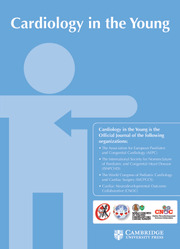No CrossRef data available.
Article contents
Improvements in cardiac geometry following bariatric surgery in adolescents help to address important knowledge gaps
Published online by Cambridge University Press: 27 October 2025
Abstract
US data from the National Health and Nutrition Examination Survey estimates that the prevalence of obesity among US adolescents (ages 12–19) has reached 22.9% of the paediatric population, with nearly 9% meeting criteria for severe obesity (body mass index ≥120% of the 95th percentile or ≥35 kg/m2). These alarming figures underscore the cumulative impact of paediatric obesity, including established associations with impaired cardiometabolic health. The study “Cardiac Geometry Alterations Following Bariatric Surgery in Severely Obese Adolescents: A One-Year Follow-Up Study of a Randomized Controlled Trial” advances this understanding by comparing lifestyle intervention alone versus lifestyle therapy in combination with the application of bariatric surgery (e.g. laparoscopic adjustable gastric banding). As the first prospective randomised trial to assess cardiac geometric and following adolescent metabolic and bariatric surgical intervention, the findings demonstrate significant improvements in cardiac geometry among surgical participants, suggesting partial reversal of obesity-related cardiac remodelling. While these short-term results are encouraging, durability remains uncertain given the study’s small sample size and previous reports of significant weight regain and higher-than-expected complication rates following gastric banding. Considerations for future investigational designs should incorporate an expanded age range with regards to overall eligibility as well as bariatric procedures other than the gastric band, that offer long-term weight loss (i.e., vertical sleeve gastrectomy and gastric bypass). Longer-term and comprehensive follow-up will be critical to delineate the longitudinal cardiometabolic outcomes of surgical versus medical interventions for severe adolescent obesity.
Keywords
Information
- Type
- Commentaries
- Information
- Copyright
- © The Author(s), 2025. Published by Cambridge University Press


